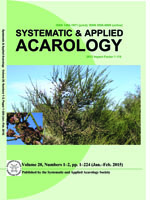The effects of the biopesticide azadirachtin-A (commercial product NeemAzal T/S; Trifolio-M GmbH, Germany) on behavior, survival, reproduction and population growth of the two-spotted spider mite (Tetranychus urticae Koch) were investigated in laboratory bioassays. The biopesticide was applied to bean leaf discs or primary bean leaves positioned on moistened cotton wads in Petri dishes by using a Potter spray tower. In a choice test, T. urticae females preferred the untreated halves of leaves over the halves treated with 50, 25, 12.5, 6.25, 3.12, and 1.56 mg/L azadirachtin-A and their oviposition in those treatments was significantly greater on untreated halves in the first 24 h, as well as its sum over 72 h (the only exception was oviposition after treatment with 6.25 mg/L). A run-off effect, ranging 4–32%, was also observed in the choice test. Viability and reproduction of survivors, as well as population growth, were affected after treatments of T. urticae females with 70, 35, and 17.5 mg/L of azadirachtin-A during their preovipositional period. All biopesticide treatments significantly reduced both gross fecundity and net fecundity (summed over seven days), the reduction ranging from 20–30% and 39–53%, respectively, compared with control. Female longevity was significantly reduced as well: treated females lived 1.4–2 days shorter than control females. All concentrations significantly lowered the instantaneous rate of increase, 11–18% against control. In females that hatched from eggs treated with 15, 7.5, and 3.75 mg/L azadirachtin-A and completed juvenile development exposed to its residues, gross fecundity was reduced 14–32%, but a significant reduction was found only after treatment with the highest concentration. On the other hand, all concentrations significantly reduced net fecundity (26–43%). Treated females lived 0.8–1.2 days shorter than control females and the reduction was significant after all treatments. The instantaneous rate of increase was significantly lowered by 15 and 7.5 mg/L concentrations, i.e. by 12% and 9%, respectively, compared with control. Sublethal effects of azadirachtin-A (NeemAzal-T/S) and its impact on the management of T. urticae populations are discussed.
How to translate text using browser tools
5 January 2015
Sublethal effects of azadirachtin-A (NeemAzal-T/S) on Tetranychus urticae (Acari: Tetranychidae)
Dejan Marčić,
Irena Međo
ACCESS THE FULL ARTICLE
azadirachtin-A
behavior
life history traits
POPULATION GROWTH
Tetranychus urticae





